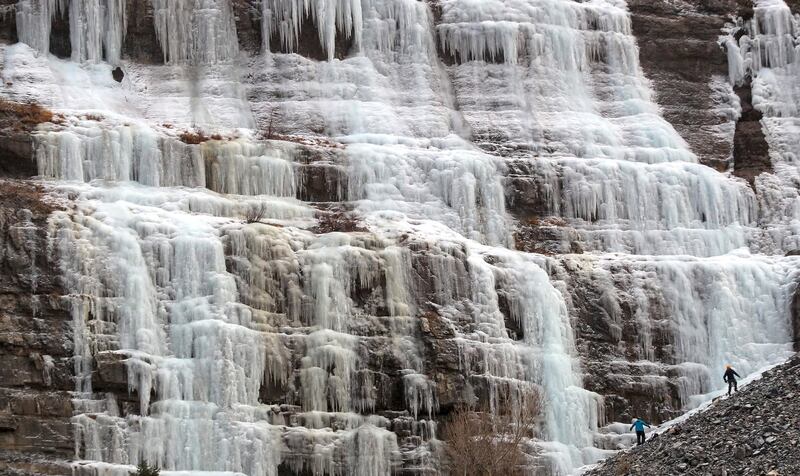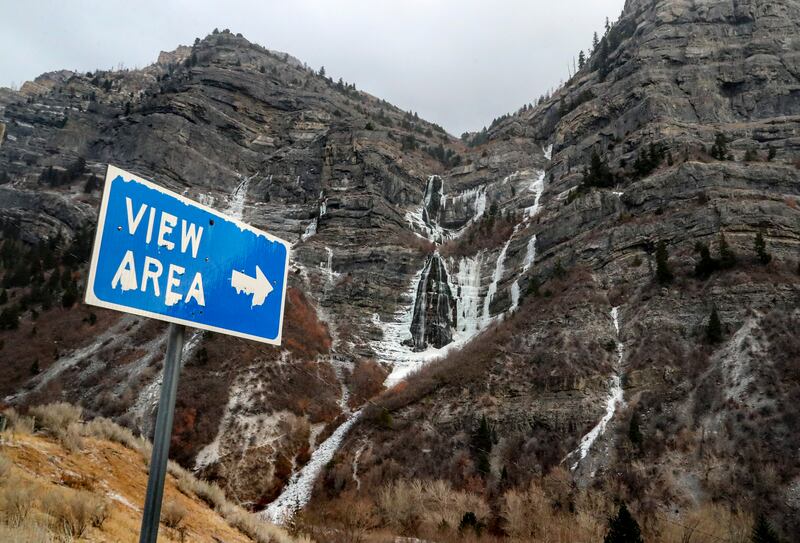PROVO — Bridal Veil Falls took a significant step toward remaining free of private developments after the Utah County Commission voted to approve a conservation easement for its property around the landmark.
The commission came to the unanimous decision during a 5 1⁄2 -hour meeting on Wednesday.
It voted to transfer the conservation easement deed to Utah Open Lands, an accredited land trust that will provide stewardship over the property as its new managers.
“I also want to make it very clear that this is not an asset that is being given to Utah Open Lands,” said Wendy Fisher, the executive director of Utah Open Lands. “This contract creates an obligation for Utah Open Lands to preserve, protect, steward and defend the conservation values as iterated by the County Commission of the landscape.”
The official recording of the deed transfer is pending the approval of the board of Utah Open Lands.
The commission’s vote looks to provide resolution to a fierce debate surrounding Bridal Veil Falls in recent weeks, as plans to privately develop the area became known.
Richard Losee, owner of the Cirque Lodge alcohol and drug rehabilitation center, had plans to build an aerial tram and lodge at the top of the waterfall.
The idea of a conservation easement to preserve the landmark from the private developments also gained support from the Provo City Council.
During the public hearing, Provo Mayor Michelle Kaufusi read a letter from her and the council that supported preserving the land from commercial development.
Cedar Hills Mayor Jenney Rees voiced similar sentiments during the public hearing and asked the county commissioners to approve an easement.

Utah County owns about 30 acres around the falls.
Before the public hearing on Bridal Veil Falls, Commissioner Bill Lee took time to push back on narratives he had seen circulating about the commission’s plans for the waterfall.
“Bridal Veil Falls has not been for sale,” he said. “That seems to be a narrative that has been pushed around over and over that Bridal Veil Falls is for sale. And the whole time that I’ve been here as a commissioner, that has never come before us.”
“There’s a narrative out there that we’re trying to do some privatization — that it is going to be privatized — and that’s a narrative that’s being spun as well that is inaccurate according to what we’ve done in the past, what we’ve voted on in the past and the continued conversations that we’ve had.”
Commission Vice Chairman Nathan Ivie said he was “grateful to hear Commissioner Lee say that it is not for sale,” noting reports of meetings between Lee and a party interested in developing the land.
Commission Chairman Tanner Ainge also supported preservation of the area, calling the waterfall a “public treasure” in a tweet on Nov. 30.
Dozens of people spoke during the public hearing, with members of the public presenting arguments for both sides, though the majority were in support of the conservation easement.
Many worried that building a tram would lead to further private developments on the land somewhere down the line, which would damage the natural beauty of the setting.
Others who spoke during the public hearing were in favor of the private developments. John Buckley, a lawyer, said he had numerous signatures from residents of Utah County who are in favor of a new aerial tramway at Bridal Veil Falls.
He also read from a statement he said was from Richard Losee.
“Mr. Losee is not proposing to close off the Bridal Veil Falls area or to restrict public access to the falls. His hope is to increase public access by restoring the Bridal Veil Falls tram. Many injuries and even deaths have occurred from attempts to scale the rugged terrain surrounding the falls. With tram access, the public will be able to observe the falls safely.”

“If all the facts were known, Mr. Losee believes that the majority of Utah residents would wholly embrace the vision of reconstructing this historical landmark for the enjoyment and benefit of all.”
Some residents agreed, saying they would support an aerial tram if it did not hinder current recreational opportunities. Others thought it would be shortsighted to permanently preclude future efforts to develop the land with amenities that could benefit all visitors.
The next step of the process, Fisher said, is taking the plans to the board of Utah Open Lands for its approval; however, she thought the proposal would likely pass.
“We do consider you all to be tremendous partners,” she said. “We think we understand, and you have tried to codify what you want to ensure the intention of this property is. So I don’t anticipate any problems, but that’s part of the process.”
If members of the board find problems with any new language or modifications in the agreement, then it will go back to the Utah County Commission.


